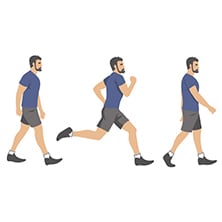Frank’s Comments: I coach all my client to use High Intensity Interval Training (HIIT) on days between weight training workouts. I especially like interval sprints on an Elliptical machine, because one can push and pull on the hand levers while pushing the legs into a sprint and get a full body workout. The principle is that intervals of sprinting push the lungs and heart to greater performance; lungs grow larger with improved Oxygen exchange, while the heart gets stronger. So warm up at a comfortable pace for 3-4 minutes, sprint hard for 10 seconds (forty yard dash), slow to a comfortable pace to recover heart-rate and breathing (3-4 minutes), then do that two more times, and you have about a 15 minute workout that will dramatically improve your overall fitness and wont eat up your day. As your fitness improves, up the sprint time as you are able, just keep it a flat-out sprint at top speed.
Interval training can help you get the most out of your workout.
Are you ready to shake up your workout? Do you wish you could burn more calories without spending more time at the gym? Consider aerobic interval training. Once the domain of elite athletes, interval training has become a powerful tool for the average exerciser, too.
What is interval training?
It’s not as complicated as you might think. Interval training is simply alternating short bursts (approximately 30 seconds) of intense activity with longer intervals (three to four minutes) of less intense activity.
For instance, if your exercise is walking — if you’re in good shape, you might incorporate short bursts of jogging into your regular brisk walks. If you’re less fit, you might alternate leisurely walking with periods of faster walking. For example, if you’re walking outdoors, you could walk faster between certain mailboxes, trees or other landmarks.
What can interval training do for me?

Should you fit HIIT ( High Intensity Interval Training) into your exercise program?
Click here for an infographic to learn more
Whether you’re a novice exerciser or you’ve been exercising for years, interval training can help you jazz up your workout routine. Consider the benefits:
- You’ll burn more calories. The more vigorously you exercise, the more calories you’ll burn — even if you increase intensity for just a few minutes at a time.
- You’ll be more time efficient. Many people don’t exercise because they say they don’t have time. Interval training enables you to complete an effective workout in less time.
- You’ll improve your aerobic capacity. As your cardiovascular fitness improves, you’ll be able to exercise longer or with more intensity. Imagine finishing your 60-minute walk in 45 minutes — or the additional calories you’ll burn by keeping up the pace for the full 60 minutes.
- You’ll keep boredom at bay. Turning up your intensity in short intervals can add variety to your exercise routine.
- You don’t need special equipment. You can perform intervals walking, running, biking, swimming or while working out on an elliptical trainer.
Are the principles of interval training the same for everyone?
Yes — but you can take interval training to many levels. If you simply want to vary your exercise routine, you can determine the length and speed of each high-intensity interval based on how you feel that day.
After warming up, you might increase the intensity for 30 seconds and then resume your normal pace. How much you pick up the pace, how often and for how long is up to you.
If you’re working toward a specific fitness goal, you may want to take a more scientific approach. A personal trainer or other expert can help you time the intensity and duration of your intervals — which may include movement patterns similar to those you’ll use during your sport or activity — based on your target heart rate, the ability of your heart and lungs to deliver oxygen to your muscles (peak oxygen intake), and other factors.
Does interval training have risks?
Interval training isn’t appropriate for everyone. If you have a chronic health condition or haven’t been exercising regularly, consult your doctor before trying any type of interval training. Studies suggest, however, that interval training can be safe and beneficial even in people with heart disease.
Also keep the risk of overuse injury in mind. If you rush into a strenuous workout before your body is ready, you may injure your muscles, tendons or bones. Interval training doesn’t have to involve high-impact exercise, ballistic or jumping movements, or heavy weights. Instead, start slowly. Try doing just one or two higher intensity intervals during each workout at first. If you think you’re overdoing it, slow down. As your stamina improves, challenge yourself to vary the pace. You may be surprised by the results.
Frank Wilhelmi – Retired/consultant electronic engineer researches and reports practical strategies for optimizing health and fitness into advanced age. “I have a passion for living life to the fullest, and helping others to do the same.” A rapidly growing body of knowledge now enables us to extend our health and fitness decades beyond popular expectations.

